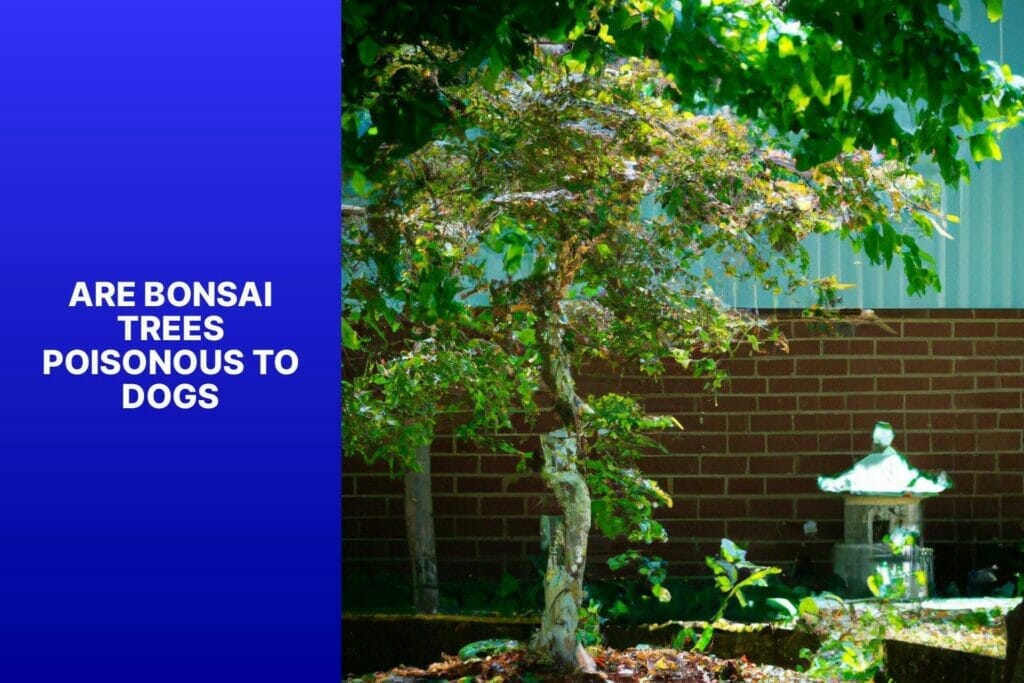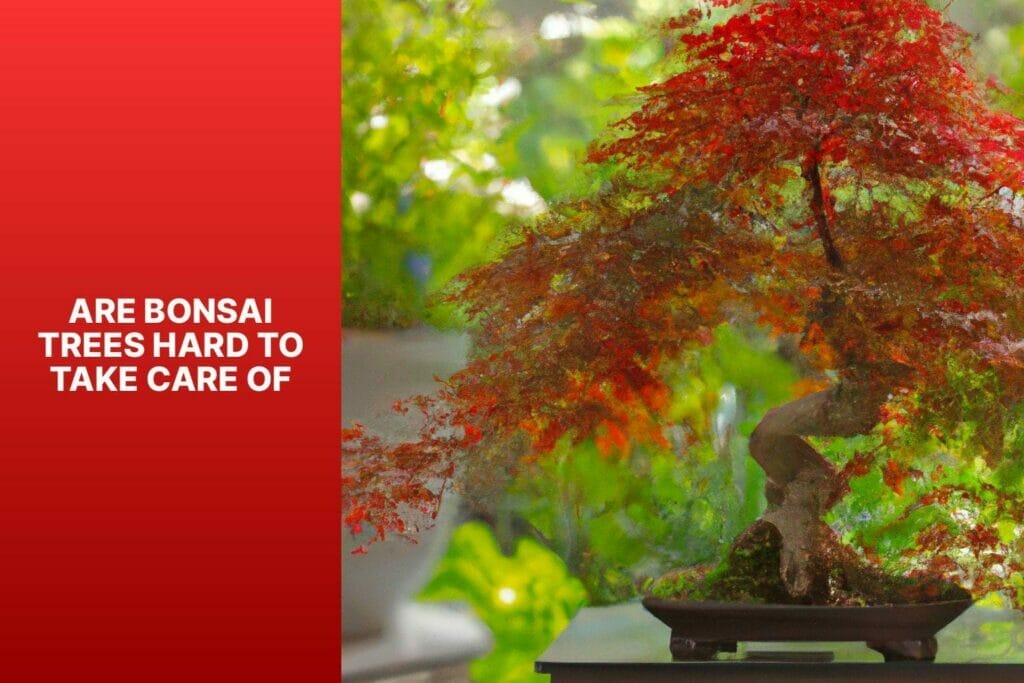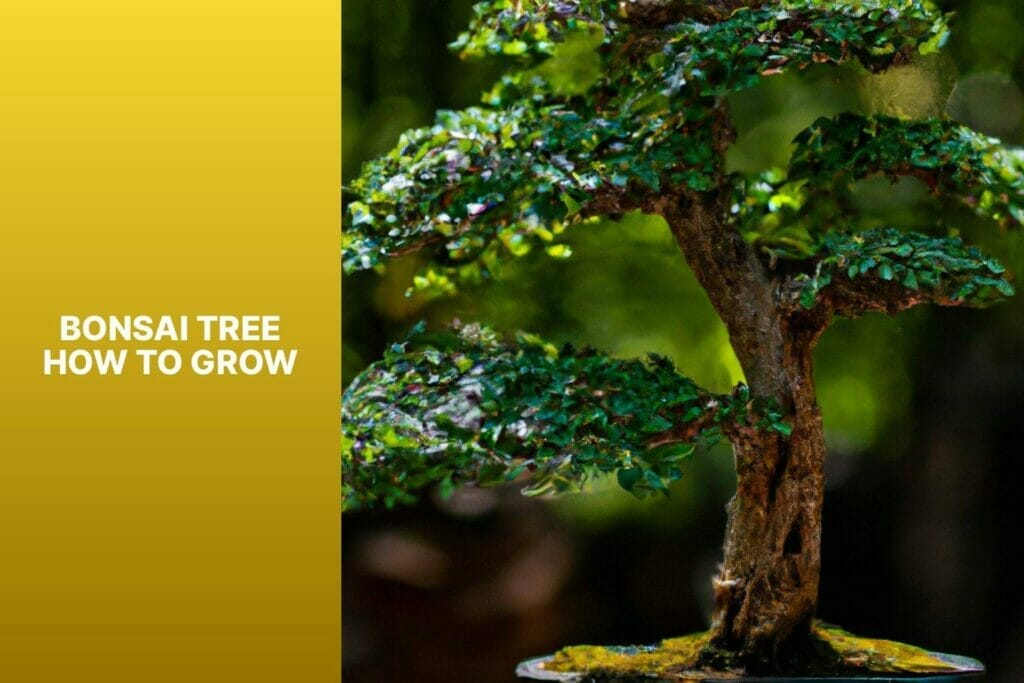Bonsai trees, known for their intricate beauty and miniature size,
have become popular among plant enthusiasts.
If you are a dog owner, knowing whether bonsai trees pose any potential risks to your furry friend is crucial.
In this article, we will explore whether bonsai trees are poisonous to dogs and discuss essential considerations to keep your canine companion safe.
Whether bonsai trees are poisonous to dogs is important for pet owners.
Some species of bonsai trees contain toxic compounds that can be harmful when ingested by dogs.
It is essential to be aware of these toxic compounds and specific bonsai tree varieties to watch out for.
This information can help you take timely action and protect your dog from harm.
If a dog ingests parts of a toxic bonsai tree, it may exhibit poisoning symptoms.
These symptoms can vary from behavioral changes and gastrointestinal issues to respiratory distress.
Recognizing these signs is vital to ensure immediate and appropriate care for your dog.
If you suspect your dog has ingested a bonsai tree, it is crucial to take prompt action.
The first step is to assess the situation and ensure your dog’s safety.
Next, contacting a veterinarian is essential for professional guidance and advice tailored to your dog’s situation.
In some cases, veterinarians may suggest home remedies to assist your dog while waiting for professional medical care.
There are a few tips to consider to keep bonsai trees and dogs safe.
One important factor is ensuring proper bonsai tree placement to prevent access by your dog.
Training your dog to avoid bonsai trees can also be beneficial.
Choosing non-toxic bonsai tree alternatives can help mitigate the risk of poisoning if you have a curious or mischievous pet.
By understanding the potential risks and taking appropriate precautions, you can enjoy the beauty of bonsai trees while ensuring the safety and well-being of your beloved canine companion.
Key takeaway:
- Bonsai trees can be toxic to dogs: Certain bonsai tree varieties contain toxic compounds that can be harmful or even fatal to dogs if ingested.
- Symptoms of bonsai tree poisoning in dogs: Dogs may exhibit behavioral changes, gastrointestinal issues, and respiratory distress if they ingest a toxic bonsai tree.
- Immediate veterinary attention is crucial: If your dog has ingested a bonsai tree, it is important to assess the situation and contact a veterinarian immediately for proper guidance and treatment.
Are Bonsai Trees Poisonous to Dogs?
Curious about the potential dangers of bonsai trees for our furry friends? Let’s dig into the question: Are Bonsai Trees Poisonous to Dogs? In this exploration, we’ll shed light on the common toxic compounds in bonsai trees and highlight specific varieties that can pose a risk to our beloved canine companions. Stay tuned to ensure the well-being of our pups and learn about the precautions we should take when it comes to these miniature wonders of nature.
Common Toxic Compounds in Bonsai Trees
Common toxic compounds in bonsai trees include volatile organic compounds (VOCs), alkaloids such as caffeine and nicotine, glycosides like oleandrin and digitalis, triterpenes such as cycasin and saponins, and phenols including tannins and phenolic acids. These compounds can irritate and cause allergies, be toxic if ingested, harm the cardiovascular system, cause gastrointestinal distress and liver damage, as well as abdominal pain, vomiting, and diarrhea in dogs.
It is important to be aware of these common toxic compounds in bonsai trees to ensure the safety and well-being of your dogs. Even non-toxic bonsai tree varieties can pose hazards if dogs chew or swallow small parts like leaves or branches. Therefore, it is recommended to supervise your dog around bonsai trees and provide safe alternatives for chewing and playing.
On a positive note, some bonsai tree species, like Japanese maple, are safe for dogs and add a beautiful and calming aesthetic to your home or garden.
Specific Bonsai Tree Varieties to Watch Out For
- Japanese Yew (Taxus cuspidata): This variety is toxic to dogs. Ingesting any part of the tree can lead to severe poisoning symptoms.
- Japanese Yew Plum Pine (Podocarpus macrophyllus): Similar to the Japanese Yew, this variety is also toxic to dogs. Keep dogs away from fallen leaves or branches.
- Japanese Black Pine (Pinus thunbergii): The needles and bark of this tree are not toxic to dogs, but ingesting pine cones can cause gastrointestinal issues. Monitor and prevent dogs from chewing or swallowing pine cones.
- English Yew (Taxus baccata): This variety contains taxines and is toxic to dogs. Keep all parts of the tree out of reach from dogs.
- Schefflera (Brassaia actinophylla): The leaves of this plant contain calcium oxalate crystals, which can irritate if dogs ingest them. Keep dogs away from this plant to prevent potential issues.
Symptoms of Bonsai Tree Poisoning in Dogs
If your furry friend has been eyeing your bonsai tree with curiosity, it’s important to be aware of the potential dangers lurking in those miniature trees. In this section, we’ll uncover the symptoms of bonsai tree poisoning in dogs. From behavioral changes to gastrointestinal issues and respiratory distress, we’ll explore how our canine companions react if exposed to these captivating yet potentially harmful plants. Stay tuned to ensure the well-being of your four-legged family members!
Behavioral Changes
Behavioral changes in dogs may indicate bonsai tree poisoning. If a dog ingests parts of a toxic bonsai tree, it may exhibit abnormal behaviors. These changes can vary depending on the severity of the poisoning and the specific compounds involved.
One common change is increased agitation or restlessness. The dog may seem more anxious and have trouble settling down. It may also act confused or disoriented, pacing or wandering.
Another change is a sudden lack of interest in food or water. The dog may refuse to eat or drink, even if it is usually food motivated. This change in appetite should be taken seriously.
Sometimes, poisoning from a bonsai tree can cause neurological symptoms like seizures or tremors. If a dog experiences these uncontrolled movements, immediate veterinary attention is necessary.
It is important to note that these behavioral changes can also indicate other health issues. If you suspect bonsai tree poisoning, closely monitor your dog’s behavior and seek veterinary assistance promptly. Early intervention increases the chances of a positive outcome for the dog.
Gastrointestinal Issues
- Gastrointestinal issues can occur in dogs that ingest a bonsai tree.
- One common issue is vomiting due to the plant’s toxic compounds.
- Another issue is diarrhea, caused by irritation to the gastrointestinal tract.
- Dogs may experience abdominal pain and inflammation.
- Loss of appetite can occur due to the affected taste buds.
- Dehydration is a potential consequence of vomiting and diarrhea.
- Excessive drooling may be observed as a symptom.
- Ingesting a large amount of a bonsai tree can lead to intestinal blockage, a serious condition requiring immediate veterinary attention.
Awareness of these gastrointestinal issues is important if your dog ingests a bonsai tree. Prompt veterinary assistance is crucial to ensure proper treatment and prevent complications.
Respiratory Distress
Respiratory distress is a serious symptom of bonsai tree poisoning in dogs. It can cause difficulty breathing, rapid or shallow breathing, wheezing, coughing, or panting. Severe respiratory distress can result in blue-tinged gums or lips, indicating oxygen deficiency. If you notice signs of respiratory distress in your dog after ingesting a bonsai tree, act quickly. Provide fresh air and a well-ventilated area to help with breathing difficulties. Keep your dog calm and minimize stress or anxiety to avoid worsening respiratory symptoms. Immediately contact a veterinarian for professional advice and guidance. Follow their instructions and bring your dog to the clinic for evaluation and treatment if necessary. Do not try to treat respiratory distress at home without professional guidance. Early recognition and intervention are crucial in managing respiratory distress in dogs and preventing complications.
What to Do If Your Dog Ingests a Bonsai Tree
If your furry friend has managed to munch on a bonsai tree, acting swiftly and responsibly is crucial. This section explores the necessary steps when your dog ingests a bonsai tree. From assessing the situation to contacting a veterinarian, we’ll cover all the essential actions you must undertake. We’ll touch upon home remedies that can immediately assist your dog. So, let’s delve into what you should do if your dog has a bonsai tree encounter!
Step 1: Assessing the Situation
When your dog eats a bonsai tree, it is important to assess the situation promptly. Follow these steps to assess the situation:
Step 1: Check for visible signs of plant consumption, such as leaves or branches in the dog’s mouth or nearby.
Step 2: Look for immediate symptoms or changes in behavior, such as vomiting, diarrhea, lethargy, or difficulty breathing.
Step 3: Consider the size and type of bonsai tree ingested. Some varieties may be more toxic to dogs than others.
If you notice concerning symptoms or suspect your dog has eaten a toxic bonsai tree, contact a veterinarian immediately for guidance. They can provide specific advice based on the situation and guide you through the next steps to ensure your dog’s well-being.
Remember, acting quickly can prevent further harm to your dog, so seek professional help without hesitation.
Step 2: Contacting a Veterinarian
- Assess the severity of the situation and check for symptoms of bonsai tree poisoning in your dog.
- Locate the contact details for the nearest veterinarian clinic or emergency animal hospital.
- Promptly contact the veterinarian and furnish all necessary information, including your dog’s breed, size, and symptoms.
- Comply with the veterinarian’s instructions or guidance provided over the phone.
- If the veterinarian advises, transport your dog to the clinic or hospital for further assessment and treatment.
- Contact a local animal poison control hotline for immediate assistance if the veterinarian is unavailable or beyond regular operating hours.
- Provide comprehensive information about your dog and the situation to the poison control hotline.
- Follow the instructions given by the poison control hotline, which may involve inducing vomiting if necessary, to alleviate the effects of bonsai tree poisoning.
If your dog exhibits severe symptoms such as difficulty breathing or loss of consciousness, seek emergency veterinary care immediately.
Step 3: Home Remedies to Assist Your Dog
Follow these steps to assist your dog if they have ingested a bonsai tree:
- Step 1: Assess if your dog shows any poisoning symptoms.
- Step 2: Immediately contact a veterinarian to inform them.
- Step 3: Only induce vomiting in your dog if directed by a veterinarian. You can also try using home remedies to assist your dog.
- Step 4: Consult a vet before administering any medications or home remedies.
- Step 5: Monitor your dog closely for behavior, appetite, or energy changes.
- Step 6: Keep your dog well-hydrated with fresh water.
- Step 7: Seek medical help promptly for severe symptoms or distress.
- Step 8: Follow all instructions and recommendations from the veterinarian.
- Step 9: Take preventive measures to keep your dog away from bonsai trees in the future.
- Step 10: Choose non-toxic alternatives to bonsai trees if you have dogs at home.
Tips on Keeping Bonsai Trees and Dogs Safe
A few key tips can make all the difference when it comes to keeping bonsai trees and dogs safe. We’ll explore practical advice on ensuring the proper placement of bonsai trees, training your dog to avoid them, and even discovering non-toxic alternatives. So, if you’re a proud pet owner with a penchant for bonsai, stay tuned for invaluable insights to create a harmonious environment for your beloved pooch and exquisite bonsai collection.
Ensuring Bonsai Tree Placement
To ensure bonsai tree safety and proper Ensuring Bonsai Tree Placement, follow these steps for proper placement:
1. Choose a high shelf or table: Position the bonsai tree out of your dog’s reach to ensure its safety and prevent accidents.
2. Secure the bonsai tree: Utilize stands or platforms to keep it steady and avoid it from being knocked over by your dog.
3. Avoid placing near windows: It is important to prevent accidents caused by dogs being attracted to outside movement or sounds. Therefore, it is best to avoid placing the bonsai tree near windows.
4. Keep away from other plants: Dogs may tend to chew on other plants, which can be harmful. As a result, it is advisable to separate the bonsai tree from other plants to ensure its well-being.
5. Consider using a barrier: If your dog is curious or mischievous, using a physical barrier like a baby gate may be beneficial to keep them away from the bonsai tree.
6. Monitor your dog’s behavior: Paying attention to your dog’s interest and curiosity level is always important. If necessary, take additional safety measures to secure the bonsai tree’s placement.
Training Your Dog to Avoid Bonsai Trees
Training your dog to avoid bonsai trees is crucial for their safety. Follow these steps to ensure your dog’s well-being and the preservation of these delicate works of art:
– Start with obedience training: Teach your furry companion commands like “leave it” and “stay” to establish boundaries and reinforce their ability to steer clear of bonsai trees.
– Create a safe space: Set up a designated area for your dog, such as a crate or playpen, where they can relax without access to the bonsai tree.
– Utilize deterrents: Apply dog-safe deterrents, like bitter apple spray or citronella, on the bonsai tree to make it less appealing and discourage your dog from approaching it.
– Supervise and redirect: Keep a close watch on your dog when they are near the bonsai tree. If they demonstrate interest, redirect their attention to a toy, treat, or other engaging activity.
– Reward positive behavior: Reinforce your dog’s good behavior by rewarding them with treats, praise, and attention when they successfully avoid the bonsai tree.
Bonsai trees blossomed into an esteemed art form in Japan’s Edo period. Dog owners were mindful of these delicate creations and trained their loyal companions to treat them respectfully and avoid disturbing their beauty.
Choosing Non-Toxic Bonsai Tree Alternatives
When considering non-toxic bonsai tree alternatives for dogs, prioritize your furry friend’s safety. Here are some options to consider:
– Air plants: These unique plants don’t need soil and can be displayed in glass containers or on driftwood. They are safe for dogs and add natural beauty to any space.
– Succulents: With their water-storing abilities, succulents are hardy and low-maintenance. Many non-toxic succulent varieties exist, such as jade plants and aloe vera.
– Spider plants: Known for purifying the air, they are safe for dogs even if they nibble on the leaves. They also make attractive hanging plants for any room.
– Herbs: Grow herbs like basil, parsley, or thyme for fresh cooking ingredients and scents that dogs may enjoy—research specific herbs for any toxic varieties.
– Peperomia: These compact, low-maintenance plants come in various shapes, colors, and textures. They are safe for dogs and can be added to terrariums or tabletop decorations.
Choosing non-toxic bonsai tree alternatives ensures your furry companion’s well-being and gives you peace of mind. Remember to keep these plants out of reach, as even non-toxic varieties can cause digestive upset if ingested in large quantities.
Throughout history, dogs have been loyal companions, aiding in hunting, herding, and providing comfort. They have become an integral part of human civilization. As we cultivate our bond with these amazing creatures, we must prioritize their safety and well-being. Choosing non-toxic bonsai tree alternatives is one way to protect our furry friends and create a harmonious living environment for all.
Some Facts About Whether Bonsai Trees Are Poisonous to Dogs:
- ✅ Many bonsai tree species are toxic to dogs, ranging from mild allergies to severe toxicity. (Source: bonsaistarter.com)
- ✅ Bonsai trees such as Sago Palms, Azaleas, and Ficus Ginseng should be avoided as they can be fatal to dogs. (Source: plantpaladin.com)
- ✅ Ingesting a toxic bonsai tree can cause immediate symptoms in dogs, including vomiting, diarrhea, and gastrointestinal pain. (Source: bonsaidubai.com)
- ✅ Prompt medical attention should be sought if a dog consumes a toxic bonsai tree, as treatment may include induced vomiting and antibiotics. (Source: bonsai trees and dogs)
- ✅ Some non-toxic bonsai dog tree options include dogwood trees, Japanese maples, and purple-leaf palms. (Source: bonsai trees and dogs)


